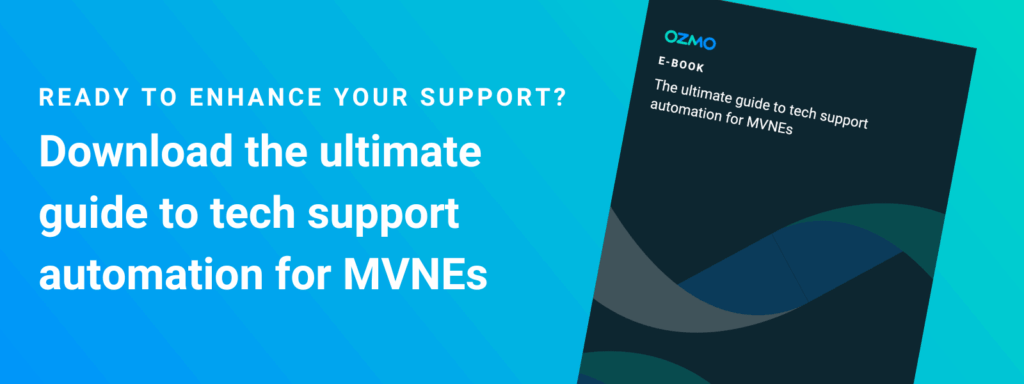Valued at $91 million, the MVNO (mobile virtual network operators) market is experiencing explosive growth. It could nearly double in value over the next decade. According to MVNO Nation USA, niche audiences, innovative business models and other revenue streams are creating new market opportunities for these service providers.
But what is an MVNO, and how is it different from a mobile virtual network enablers (MVNE)? Below, we go over what an MVNO is, how it’s different from an MVNE and how MVNOs can prepare for the future of tech support.
Table of contents
- What is an MVNO?
- What is an MVNE?
- MVNO vs. MVNE – who owns the support experience?
- Common support challenges for MVNOs
- How MVNOs can future-proof support ecosystems
- Key takeaways for business leaders
What is an MVNO?
An MVNO provides telecom services to customers without owning any of the underlying infrastructure. This makes them different from mobile network operators (MNOs), which offer telecom services but also own the infrastructure used to power these offerings.
Since these service providers don’t have to maintain costly infrastructure, they can offer customers cellular plans without the eye-watering prices of some MNOs. Examples of MVNOs include Consumer Cellular, Mint Mobile and Twigby.
MVNOs are customer-facing, prioritizing affordable pricing and the customer experience. These service providers must provide fast technical support and digital customer onboarding to millions of customers. Seven out of 10 customers will abandon the onboarding process if it takes longer than 20 minutes to complete.
Additionally, 96% of customers will stop doing business with a company after one bad service experience. That’s why the customer experience is a top priority for these businesses. MVNOs like Twigby compete on quality customer service rather than infrastructure. Providing smooth customer onboarding and tech support is critical for standing out in an increasingly competitive telecom market.
What is an MVNE?
MVNEs, or mobile virtual network enablers, work behind the scenes to support MVNOs. MVNEs provide the infrastructure and technology MVNOs rely on, and are the backbone of successful MVNO launches. To put it simply, MVNOs outsource business and technical operations to the MVNE. This enables the MVNO to reduce business costs and focus on delivering a superior customer experience.
In addition to handling core business and technical services, MVNEs can empower MVNOs with tech support automation. For example, an MVNE can create tech support documentation that MVNOs can then customize to their unique brand.
Customer service tools can be critical for MVNEs trying to acquire new MVNO customers. Since the customer experience is crucial to MVNO success, tiered tech support offerings can help MVNEs differentiate themselves from competitors, attract new clients and reduce customer churn. However, while MVNEs offer the automated support technology, it’s up to the MVNO to customize it to its unique branding and customer needs.
MVNO vs. MVNE – who owns the support experience?
MVNEs and MVNOs are intricately intertwined in day-to-day operations, meaning the lines between their scopes can blur. Here, we compare the roles, responsibilities and scope of both MVNEs and MVNOs regarding technical support.
| Function | MVNE | MVNO |
| Provides core services | eSim activation, network access, etc | Not involved |
| Support tools (ticketing, device and application support) | MVNEs may offer/resell tech support tooling to MVNOs | MVNO can white label and customize to branding |
| Customer-facing support | Provides the tools to the MVNO | Responsible for CX and case escalations |
MVNEs work behind the scenes to provide the technical and business resources MVNOs need to power telecom services and customer support. However, the customer experience, support ticket resolution, workflows and outcomes fall on MVNOs.
The MVNOs are responsible for the touchpoints and processes that involve telecom customers, while MVNEs work behind the scenes to provide the tools that enable successful customer interactions.
So, how can MVNO leaders work to prevent fragmentation and ensure a seamless customer experience? It’s best to clarify early which party is responsible for what in the service level agreement (SLA). Doing so makes sure everyone is on the same page and ensures a smooth experience for both the MVNO and its customers.
Common support challenges for MVNOs
MVNOs face a variety of customer service challenges. If left unaddressed, this creates a poor customer service experience that can have detrimental impacts on the company’s bottom line.
Two-thirds of customers say customer experience is a crucial factor in their buying decisions. Failure to meet their expectations can lead to higher customer churn rates. Below, we outline some of the most critical support challenges facing MVNOs.
Long call center wait times
No one likes to wait on hold. Long call center queues can kill the customer experience before a customer even interacts with a brand. Customers expect businesses to respond to their communications within five minutes or less.
MVNOs that struggle to deliver timely responses are more likely to experience high customer churn rates. It costs up to seven times more to acquire new customers than to retain current ones. An MVNO with increased churn rates risks a hit to both its profitability and budget. MVNEs offering tools like conversational AI chatbots can help MVNOs shorten wait times or allow customers to bypass the call queue entirely.
High agent turnover
This can contribute to problem number one. The customer service agent turnover rate is 45%, much higher than in other professions. Contact centers that lack adequate staff to field customer inquiries struggle to give prompt responses to customer inquiries, which can lead to poor-quality tech support and increased customer rage.
The constant search for new talent to staff call centers adds up fast. Research shows it can cost up to twice an employee’s salary to replace them. This means an MVNO dealing with high agent turnover can take a hit on two fronts: both to its budget and to its customer retention rate. Prioritizing strong agent onboarding programs and other steps to improve employee engagement is critical for good customer experiences.
Inconsistent customer support experiences
Omnichannel customer service is vital for enhancing the overall customer experience. Many contact centers use multichannel support models, which are often siloed, resulting in inconsistent tech support experiences that vary across platforms such as email, phone or chat.
A comprehensive support platform ensures that all customers have a streamlined and cohesive experience, regardless of the channel they choose. The quality of tech support and access to knowledge bases is consistent, whether users decide to call in to a contact center, send an email or interact with AI chatbots.
How MVNOs can future-proof tech support ecosystems
The future of tech support is already here. Customer expectations are rapidly changing, and telecom companies need to keep up to stay competitive in an increasingly crowded market. Below are a few ways MVNOs can prepare for the future of tech support today.
Centralize tech support knowledge bases
MVNOs need to make it easy for customers and agents alike to find answers to their questions quickly. Companies should use a centralized knowledge base to ensure everyone can access the information they need in their preferred way (such as through a chatbot, email etc).
Additionally, to streamline the tech support process for everyone, MVNOs should prioritize solutions with knowledge bases that dynamically update. Customers and agents need answers fast. With multiple software updates throughout the year, it’s easy for information to become stale. Because time is short for telecom companies, a dynamically updated knowledge base automatically ensures information is current so teams don’t have to edit it manually, saving valuable time.
Embrace live video support
There’s no doubt that live video support is the future of customer service. Live video support greatly improves communication between customers and agents, allowing agents to resolve tech support tickets faster than speaking to someone over the phone. This enables MVNOs to save valuable time and money.
Live video can also create the personalized service experiences customers crave. Businesses that use personalization see a 20% increase in customer satisfaction. Video-based customer service is a powerful tool for any MVNO looking to differentiate its brand.
Use a mixture of artificial intelligence (AI) and humans in contact centers
There are numerous benefits to using chatbots and other AI technologies in customer service. However, AI can’t replace humans entirely. Contact center agents still have a vital role to play in tech support. Many customers still prefer to speak to a person about a tech support issue. Additionally, the majority of customers cite friendly agents as a key factor in their loyalty to a brand.
So, while large language models (LLMs) are reshaping customer service, call centers will use a combination of humans and AI. AI will help agents save valuable time and work smarter, not harder, to resolve tech support tickets.
Key takeaways for business leaders
Even though MVNEs and MVNOs are closely intertwined, each has a distinct role in telecom customer support. MVNEs provide the infrastructure and tools, while MVNOs own the customer-facing experience. For MVNO leaders, choosing the right MVNE partner and support strategy is essential to standing out in a competitive market.
Want to learn how MVNEs can use automation to deliver scalable, efficient support for their MVNO partners? Download the e-book on tech support automation for MVNEs to explore best practices that improve customer satisfaction, reduce churn and future-proof your business.




